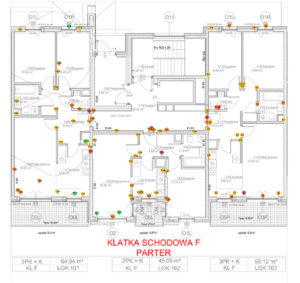The building review service and final acceptance of the general contractor works after completion of construction is dedicated to developers who care about their good reputation. Checking the quality of the finishing allows to avoid many problems when handing over the premises to future tenants and significantly increases customer satisfaction.
Which companies can use this service?
The investment review is commissioned by developers, who use services of an independent external companies as element of control of the construction works standards and maintaining high quality of the product. It can be beneficial for both types of development companies – those who conduct construction works in the general contracting system and those who use the construction management method.
Site supervision during and after the construction
During the construction works, the supervision inspectors appointed by the investor ensure that the construction is carried out safely, in accordance with the provisions of the building law and the best technical knowledge. They check and accept subsequent elements of the building, including all temporary works, that are strategic for the entire facility. However, at the end of the construction, there is often not enough time to go through all the apartments one by one and take over each of them in detail from the general contractor. This is a problem and a disadvantage in virtually every construction site, therefore commissioning an external company to perform the handover of apartments is a common practice. It is often determined by economic reasons – the acceptance service provided by an experienced company using new technologies is effective and fast, which allows for certain cost optimization. The undoubted additional value of this service is also the “fresh look” at the completed facility from the point of view of technical experts not previously involved in the construction of the building.
Stage I – take over from the General Contractor
The process begins with a thorough familiarization with the design documentation, the developer’s standards, which constitute an appendix to the sales contract, and the apartment catalog sheets with tenants’ changes. The design documentation obtained from the developer in an electronic version is uploaded to the program that supports the acceptance process and is used to identify snags. Then, teams under the supervision of licensed supervision inspectors review the apartments in terms of technical standards, finishing standards set out in the development contract, as well as the quality and aesthetics of the works performed.
Standards and regulations
The most commonly used standards and regulations when checking apartments are:
- PN-B-10110:2005 – Gypsum plasters applied mechanically. Technical principles and requirements.
- PN-70/B-10101 – Plaster works. Plain plasters. Requirements and acceptance tests.
- PN-EN 1279-1:2018-08 – Glass in building industry, insulated glass. General requirements and visual quality.
- PN-88/B-10085 – Construction joinery. Windows and doors.
- PN-53/B-1014 – Floor underlays. Stone and clinker tile floors.
- Regulation on technical conditions to be met by buildings and their location

The report begins with general comments on repetitive snags occurring in many premises. The snags are numbered and categorized, their exact location is indicated on the plan with comments and pictures attached. At the very end of the report, there are entire floors plans with all the snags marked to better illustrate the scale of the problems. An Excel file is attached to the report for easier filtration of the snags by category and distribution to individual contractors for removal.
The most common snags

After the snags are removed by the contractors, the premises are inspected again and the so-called “cleaning” takes place, i.e. checking whether the snags have been removed and changing the status of deficiencies in the report. Only then is the facility ready for the second stage, i.e. acceptance with tenants.
Stage II – acceptance with tenants
Currently, more and more customers engage technical specialists for the apartment acceptance. Experts spot the smallest defects, but they are not always justified and may not be classified as a defect in the light of the technical conditions of the construction law. The 2PM team, participating in the acceptance committees as an external entity, is able to objectively determine whether the deficiencies found are justified in the context of the developer’s technical conditions and standards, whether it is suitable for a complaint and has a chance for a positive consideration. For example, the client reports a deviation of the plaster plane in the corner of 2 mm, and according to the standard, the permissible deviation is 5 mm, so it is known in advance that it will not be taken into account, but will only extend the procedure. Frequent polemics concern very cosmetic issues, such as flecks from the roller left on the walls after painting. The customer raises objections to them, while the developer’s standard only guarantees third-class cement-lime plaster. The walls were additionally covered with gypsum and painted (in addition to what was offered in the standard) for a better final effect, so the customer’s reservations in this case will also not be taken into account.
The participation of an independent external company not only allows to accelerate the process of handing over the premises to the client, but also can protect the investor from a wave of unjustified deficiencies, which would have to be adequately addressed.
Execution time

The role of an external company does not end with the acceptance and handing over of flats to tenants. The Common areas of the property, parking spaces in the underground garage, storage rooms and lockers, as well as service premises are also subject to inspection.
Check your housing development with us before proceeding to tenants acceptances – contact us for an offer and more information.
